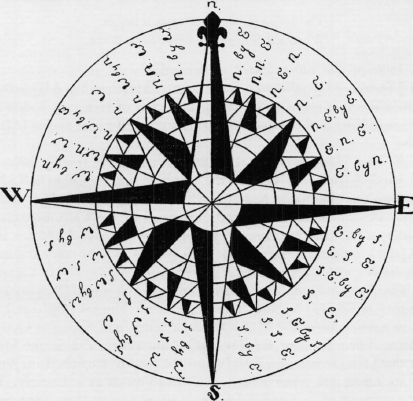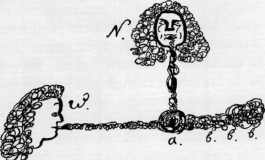Chapter 14
Of Aiery-Meteors
AIERY Meteors are all Winds whether above or below the Earths surface.1
1. Above commonly cal’d winds consisting of Earthy fumes which [ascend] by the Suns beams reflected are repelled by the Cold watry Clouds [of] the middle region, and being not able to discend because of the beams that lift them up, nor ascend farther because of the Clouds they are put in motion sidwise one way or other according to the Site of the lower Surface of the first repelling Cloud. Of this consider [the turning, ceasing, and Divisions.]
1. The turning which is by another Stronger wind raised in some other parts of the Earth. Hence upon the Change of [a] wind we see the Clouds going another way than that wherein the wind moves near the Surface of the Earth till at last the whole moveable matter is wrapt into one and the same course.
2. Ceasing is by spending all its fume in the motion beyond the repelling Clouds, where it has liberty to Ascend higher, and disperse itself, and then if the Clouds be heavy and Pregnent this obsticle being removed, they [still] fall down in rain, [else] not.
Earth fumes ascending stopt by Clouds is wind
turns by a stronger lets Clouds fall behind.
3. The Division[s] of Winds [are] in respect of [Strength, Time, line, and Purity.]
1. [In respect of] Strength, and Weakness [which] is according to the Quantity (more or less) of the fumes collected togather.
N.B. the Gentle breize that blows from E. to W. Within the tropicks (commonly cal’d the trade [wind]) is not so properly a Wind as the Whole Atmosphere, Slower in its motion than the [Earths Surface], In those parts under the Greater Circles, [for there] the Surface of the Earth must move 21000 miles in [a] day, (or 24 hours) which [is about 900 Miles in an hour; but this] Swiftness decreaseth in the [lesser] parrallels till it come to nothing in the poles. Thus we see in a Still air if a man Rides or runs Swiftly he feeles (as it ware) a Wind beating in his face, when indeed there is none Stirring, as he finds when he slacks his [course] or stops; So it is in this [case] for though the Earth Going about carryes the whole atmosphere with it, yet it being a fluid cannot So soon receive the Impression or continue [the] motion altogather so fast as the Earth itself in that part thereof, [and] therefore it seams to go the Contrary way; and this the more when the Sun arising rarifyes the atmosphere, makes it thinner, [and] lighter, and less adhæring to the Earth because all day the Steams are ascending; but in the Evening when the Steams fall down again or rise less they Stick more firmly to the Earth, are carried more swiftly with it, and near to its own course, and then (in the night) [they] have little or none of the breize, and for this reason also we have [no such] breize neare[r] the poles; Not only for that the Earths Surface moves more slowly [here] having a less compass to go in a day, but because [our] Atmosphere is more heavy and adheres more firmly to the Earth.
The breize within the tropiks is begun,
When Earth dos fluid atmospher out run.
2. In respect of times, Stated, or Irregular.
[1.] Stated, or Certain times, Such as [our] March winds, May Storms, Michelmas winds etc: Caused by the Influence of Heavenly bodyes annually according to the Seasons preparing and [raising] the matter of [the] winds.
N.B. The [Monsoons] in the East-[Indies], with [their] following trade wind[s] ([blowing] one half the year N.E. and the Other half S.W.) must have their particular reason[s] which we cannot so steddyly assign, because we cannot be So distinctly informed of the Circumstances of Counteryes So remote [However] from what we have heard we shall offer [this] conjecture, tis Said that after about a months rayne the mansoons breake up or begin to alter [their course,] generally in October, that is the beginning of their Summer (on the South side of [the] line) and then they settle [45] to blow from N. E. for 6 Months [togather,] this may be answerable to the March winds, it being [our] Spring as October is theirs. Their Summer rarifyes [the] Atmosphere, and So the breize ([for that] the [Indian]-sea [lyes] about the [South] tropick [Line]) may have its Effect and communicate to them so much as is Easterly. The Vast continents of Asia and Affrica may afford Steams [for their continuance, and the vapours arising from the Summers dissolution of Snow in the African Mountains, may afford clouds, to turn the Steams Southwards toward] the Indian sea lying that way from them. Add also to this the bending of the mountaneous Ledg Going forth to the [Cape] of Good-hope all which togather may contribute to the [Southerly] motion of the Steams; these causes continuing may hold the Wind or breize N.E. for all the Summer, half a year; But in aprill (which begins their Winter) Either the Sun going [off] no[r]thward draws the Steams after it, or parhaps the Clouds which first turn’d it, may be dissolved, and discipated or rather the Vapours of the Atlantick sea may be so Great as to turn all the Steams the other way, and overbare the breize. And this may answer our Michaelmass Winds Which are Generally S.W. or at least westerly [and So continue] all the Winter long.
From breizes steams, Clouds the mansoons are N.E.
from the Atlantick vapours South, and West.
2. Irregular [winds (without Stated times)] are more accidental[ly] various, and Unexpected, though they have their natural causes also but not So perceptible by us.

3. In respect [of] the [line] of the Winds motion and that [is] either direct or Circular.
1. Direct, [any] Strait line from any Coast of heaven and So they are discribed in the mariners compass to 32 points whereof
1. Cardinall, 4. E.W.N.S.
2. Collateral all the rest:
Now for getting this [easily] into memory, I recommend the division of them into
1. Whole Winds (the 4 Cardinal[s].)
2. [Half Winds] (the 4 middles) N E: S E: N W: S W.
3. Quarter Winds (the 8 Middles between the Wholes and halfes) as N N E // E N E // E S E // [S S E], etc:
4. By Winds 16. Assigning 2 to each Whole and ½ Wind one upon Each side, as N. and by [E.], N E and by [N N E], etc: Also the Compass useth to be learned with application to time giving [to] Each Point ¾ of an hour; Saying N and by E. ¾ of an hour, N N E. an hour and half, etc
2. Circular winds (Called Whirlwinds) [caused] by the meeting of 2 Winds from Diverse Quarters that are of near Equall strength which when they hinder [one anothers] progress they both joyn in turning round, and So become Stronger than either of [the 2] apart. These Usually lift up things from the Earth, because more of the fume rushes in still from each wind into a narrow space till it can no longer [contain] it, then having still motion it must goe one way or other Downwards it cannot for the Earth; [nor] forwards [because] Each obstructs the other. Therefore upwards is its freest course, where the fume has rome to diffuse itself, and So it Ends. Yet be sides the Circular it has Som what of a progressive motion for a while which is determined by the [Stronger] of the 2 winds. [As Suppose (N.) the] North wind overpowered by [(W.) the Stronger west] wind [do cause] the Whirle to begin at (a) then they have their progression [in] the course (b b b.) because [(W.)] is Stronger then [(N.)] but if the winds ware Supposed to be equal exactly in Strength [then] would be no progression but only ascent. [46]

4. In respect to the purity or mixture, [This Mixture is] with fire or Water.
1. With fire (Called blasts) which may be conceived to have a mixture of Nitro sulphurious particles; which in [the] ascent before they come so high as the place of thunder are snatched aside by [a] wind, and thereby Vehemently impressed on plants, or animals, and dos them hurt especially in their more tender parts as in the buds, leaves, or blossoms of plants, and in the Eyes of Animals.
2. With Water (called Storm) tis when the abundance of Watry Clouds press low, and Streighten the wind[s] into a narrow Space; whereby the matter of [wind] being more dense becomes more vehement; and being mingled with some of the rain which can be no longer held up, [it] falls, and [presses] more heavily on bodyes that Chance to stand in its way this is mischeivous to Ships not only by its force but by moistening the Sails, it makes them hold wind the more, and by wetting the Cords and Decks makes them slippery, and beats the men from their work. And thus much for winds above the Earth.
[Blasts mixt with fire hurts plants and Animals
And watry Storm grevious on Sailor falls.]
2. Under the Earth in the Caverns thereof are [also] winds raised and included Commonly cal’d Earthquakes from the Effect [thereof]. The Production of these may be thus conceived, the Earth in its looser composition hath air [and] water intermixed, and these togather fill all the Space within the [Earth’s] Surface. But upon the Accression for the Stone Sticking [closer] to the rocks, [there] must [be left] cleffs [or] spaces which become the Allimbicks [for] fountains in their ordinary Use (as is before noted) but when the steams [that arise in them] are [too] hot to be condensed to water which may happen either from certain influences of the heavens or from extraordinary fermentation, or from the disposition of the matter steaming, and being so sent up in greater [quantity] than can Evaporate, and being also agitated by [their] Greater fermenting heat, they Vehemently seek an outlet, and meeting with obstruction therein, they rush violently [where they can] in those caverns, and [cause] the Adjacent parts of the Earth to Shake in diverse [manners]. [Hence they distinguish] Earthquakes into [the] stroake, and trembling.
1. [The] Stroake whereby the Surface of the Earth is moved upwards, and downwards.
2. The trembling whereby the motion is forwards, and backwards horizontally; both [are] according to the Site and [figure] of the Caverns and the motion of the Exhalation; the Issue of [this is] breaking forth either in the many outlets of Springs, or in [some] one place by rending the Surface and making a Great Chasm [in] the Earth. This if it happens [in] the Sea throws up [those] wonderfull and daingerous Spouts, common in some seas, but If at Land it somtimes distroys Sityes, and overturns mountains, [and] removes them [intire] out of their [place]. These things happen most in rocky, mountain[ou]s, and mineral countryes and are commonly accompanyed with Subterraneous noys (like [that of] thunder,) by the Impetuous stroakes of the Exhalation against the sides and Ends of the Caverns.
In Subterraneous caverns winds do frollick,
When Mother Earth is troubled with the Cholick.
